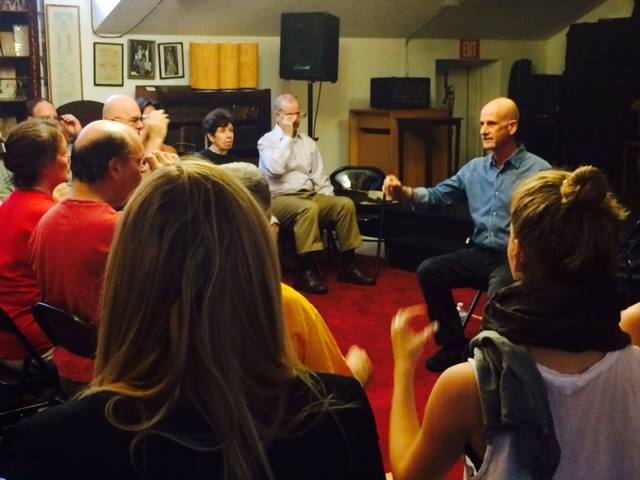 There are so many Alexander Technique directions, or verbal cues, it would be impossible to list them all. In fact, many of them have yet to be formulated, because Alexander Technique teachers will think of them in the moment, for situations as they arise.
There are so many Alexander Technique directions, or verbal cues, it would be impossible to list them all. In fact, many of them have yet to be formulated, because Alexander Technique teachers will think of them in the moment, for situations as they arise.
Directions may be universal such as: ‘let your neck be free’, ‘let your torso lengthen and widen’, or, very specific such as: ‘let your fingers gently wrap around the drumsticks’, ‘think of the guitar pick as an extension of your fingertips’ ‘hold the knitting needles with the minimum amount of tension’.
Some directions may be quite lengthy, so shortcuts enable the Alexander Technique to be more practical in our daily lives.
For example, there is a procedure, or an Alexander Technique exercise, called ‘hands on the back of the chair’ (HOBC).
Let’s say you are doing HOBC while seated. You may want to start with the primary Alexander Technique direction to allow your neck to be free, so that your head can rotate forward and up. Let your torso lengthen and widen. Let your entire torso- front, back, and sides, move as you breath. Allow your sit bones to release down into the chair.
Pivot forward using only your hip joints as hinges. Then let one hand at a time move towards the rail of the back of the chair in front of you. Initiate the movement by thinking of leading with your fingertips. Use the least amount of tension as possible. Use your biceps or shoulders minimally. Once your hand reaches the chair rail, lightly grip the chair with your fingers opposing your thumb. All your fingers are pointing straight down. Think of your elbows going back and down, opposing your wrists. Think of the wrists moving towards each other as you gently think of pulling the chair apart.
These are just a few general, generic directions for HOBC. (Alexander Technique teachers help you with the details.) This Alexander Technique exercise has practical applications, and you could use aspects of HOBC every time you move your hands towards a computer keyboard, or anywhere else.
Combine all these directions and call it ‘HOBC thinking’. Anytime we move our hands, which is 5,263 times a day, we can use aspects of HOBC thinking as we move our fingertips towards anything. HOBC thinking helps us move our hands easily and effortlessly, reducing stress and pain.
This same idea can be applied to full natural breathing, shortcutting another Alexander Technique procedure (the whispered ah), and calling it ‘whispered ah thinking.’
This idea can be applied to the Alexander Technique in general, the shortcut being ‘Alexander Technique’.
Some students have suggested the following shortcuts for the Alexander Technique directions: Up, AT, free your neck, and breathe.
Do you have any shortcuts for any aspect of Alexander Technique work?
Mark Josefsberg-Alexander Technique NYC
(917) 709-4648










I always liked Alexander’s phrase “one after the other and all together” in describing directions, so I often think to myself just “all together”.
Thanks Adrian,
All together is a great one. It occurs to me that using shortcuts like these make the directions more general, more holistic, and more open to interpretation. F.M.Alexander used terms that he thought were ‘vague’ purposefully. I think it goes along with the Alexander Technique idea that ‘concentration’ isn’t always a good thing; sometimes it’s beneficial to have a more global look. Seeing the whole rather than the parts. Seeing things altogether all together.
Short cuts – what a great way to put it! It can be easy to get overwhelmed by the amount of the directions we want to give at any moment, and can also lead to an “over-management” that moves us away from freedom and ease of movement. I’ve found just thinking “no” to be very effective if I notice some habitual patterns of tension creeping in – a short cut, I guess, for thinking “No, I’m not tensing, I’m letting my neck be free, my back lengthen and widen, etc. etc.”
Thanks Imogen!
I couldn’t have said it better! In fact I didn’t say it better. We Alexander Technique teachers know enough to give directions for hours. When someone is going from standing to sitting, there isn’t time for all that, so shortcuts are great. ‘No’ is about the shortest one I could think of!
I think this is called “chunking” in neurophysiology. We often use it without thinking, like when memorising a telephone number. It is a great idea to do it consciously when practising direction!
Halvard Heggdal
Thanks Halvard!
This idea of ‘chunking’ resonated with me immediately! I’m so glad you told me that. Jazz musicians, and probably all musicians, utilize this same concept all the time for memorizing chord changes, structures etc. As far as the Alexander Technique is concerned, I believe teachers do it all the time. We have to, though some Alexander Technique teachers really object to the term ‘shortcuts’, but that’s ok! It’s good to re examine habits of thought, and immediate reactions, don’t you think?
hi mark,
this is wonderful blog describing FM technique.
i liked this blog.
any how, i shocked reading the ”’FM use of the self evolution of the technique”’
and noticed the below points alltogether…
1) and fm tried with neck to prevent his gasping of breath, and he failed
2) he tried with neck,head and failed
3) he tried with neck,head,torso to prevent his sucking of inbreath and he failed
4) he tried with neck,head,torso,legs and still he failed
5)he tried with neck,head,torso,legs,arms and finally he succeeded.
the 5 the point is the major major major one which points to the alexander concept of PHYSCO-PHYSICAL UNITY.
i like throwing the first four points in the garbage and always remember the alexander the above stated 5 th point.
any how the above stated first 4 points will not work based on our faultysense which was debauched.
i love to practice with the whole body and directing the energy and fm alexander story is my BIBLE.
I TRUST FM’S PHYSCO-PHYSICAL UNITY FOR EVER.
hi Jagesh,
I’m glad you liked the post. It sounds like you’re a pretty strong believer in the Alexander Technique!